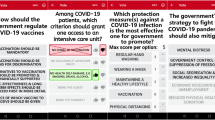Abstract
Today, group decision making in our democratic society uses the non-ranked method. What we need is an improved method that allows decision makers to indicate not only their chosen alternative, but also their order of preference by which all alternatives will be placed. We classify this as a particular Social Choice Function, where choice is a group decision-making methodology in an ideal democratic society that gives the expression of the will of the majority. We use the Eigenvector Function to obtain individual priorities of preferences and Borda’s Function to obtain the Ranking or otherwise, the Group Choice. Our conclusions give rise to new directions for pervasive democracy with an innovative degenerative quantum scale to allow even for strong to very strong preferences.
Preview
Unable to display preview. Download preview PDF.
Similar content being viewed by others
References
Saaty, T.: Models Methods and Applications of the Analytic Hierarchy Process. International Series. Kluwer Academic Publishers, Dordrecht (2001)
Saaty, T.: Deriving the AHP 1-9 Scale from First Principles. In: ISAHP 2001, Berne, Switzerland (2001)
Dwork, C., Kumar, R., Naor, M., Sivakumar, D.: Rank Aggregation Methods for the Web, Hong Kong, May 1-5 (2001)
Roure De, D.: Semantic Grid and Pervasive Computing, IPv6 Global Summit in Madrid (2003)
Belluzo, D.: http://www.informit.com/articles/article.aspx?p=165227
Gerstner, L.: http://en.wikipedia.org/wiki/Lou_Gerstner
Weiser, M.: http://en.wikipedia.org/wiki/Mark_Weiser
MIT Project Oxygen, http://www.oxygen.lcs.mit.edu/
Sun, http://www.sun.com
Microsoft, http://www.microsoft.com
Adobe, http://www.adobe.com
Oracle, http://www.oracle.com
List of Ubiquitous Research Centers
http://en.wikipedia.org/wiki/List_of_ubiquitous_computing_research_centers
Ubiquitous Computing, http://en.wikipedia.org/wiki/Ubiquitous_computing
Computer Supported Cooperative Work, http://en.wikipedia.org/wiki/CSCW
Human Computer Interaction
Antoniades, A.K.: A Prototype Multi Criteria Group Decision Support System Using the Analytic Hierarchy Process. In: 1st International Scientific Conference on Information Technology and Quality (2004)
e-Government, http://www.epractice.eu/en/eGovernment
Bardram, E.J., Christensen, B.H.: Pervasive Computing Support for Hospitals: An Overview of the Activity Based Computing Project. IEEE Pervasive Computing 6(1), 44–51 (2007)
The Java EE Tutorial, http://java.sun.com/javaee/5/docs/tutorial/doc/index.html
p-Democracy, http://www.p-democracy.net (to be completed in September)
Java Authentication and Authorization Services
http://java.sun.com/javase/6/docs/technotes/guides/security/jaas/JAASRefGuide.html
Adam Greenfield, http://en.wikipedia.org/wiki/Adam_Greenfield
Java EE Containers, http://java.sun.com/javaee/5/docs/tutorial/doc/bnabo.html
Java ME, http://java.sun.com/javame/index.jsp
Eclipse, http://www.eclipse.org/
Tomcat Sever, http://www.coreservlets.com/Apache-Tomcat-Tutorial/eclipse.html
HTTP Server, http://httpd.apache.org/docs/2.0/
Taylor, T.: http://tomtaylor.co.uk/about/
Bardram, E.J.: The Trouble with Login – On usability and Computer Security in Ubiquitous Computing. Personal and Ubiquitous Computing 9(6), 357–367 (2005)
Field studies (to be published)
Saaty, L.T., Forman, H.E.: The Hierarchon. A Dictionary of Hierarchies. V of the AHP Series. RWS Publication (2003) ISBN: 0-9620317-5-5
Author information
Authors and Affiliations
Editor information
Editors and Affiliations
Rights and permissions
Copyright information
© 2010 ICST Institute for Computer Science, Social Informatics and Telecommunications Engineering
About this paper
Cite this paper
Antoniades, K.A. (2010). p-Democracy a Pervasive Majority Rule. In: Sideridis, A.B., Patrikakis, C.Z. (eds) Next Generation Society. Technological and Legal Issues. e-Democracy 2009. Lecture Notes of the Institute for Computer Sciences, Social Informatics and Telecommunications Engineering, vol 26. Springer, Berlin, Heidelberg. https://doi.org/10.1007/978-3-642-11631-5_39
Download citation
DOI: https://doi.org/10.1007/978-3-642-11631-5_39
Publisher Name: Springer, Berlin, Heidelberg
Print ISBN: 978-3-642-11629-2
Online ISBN: 978-3-642-11631-5
eBook Packages: Computer ScienceComputer Science (R0)




